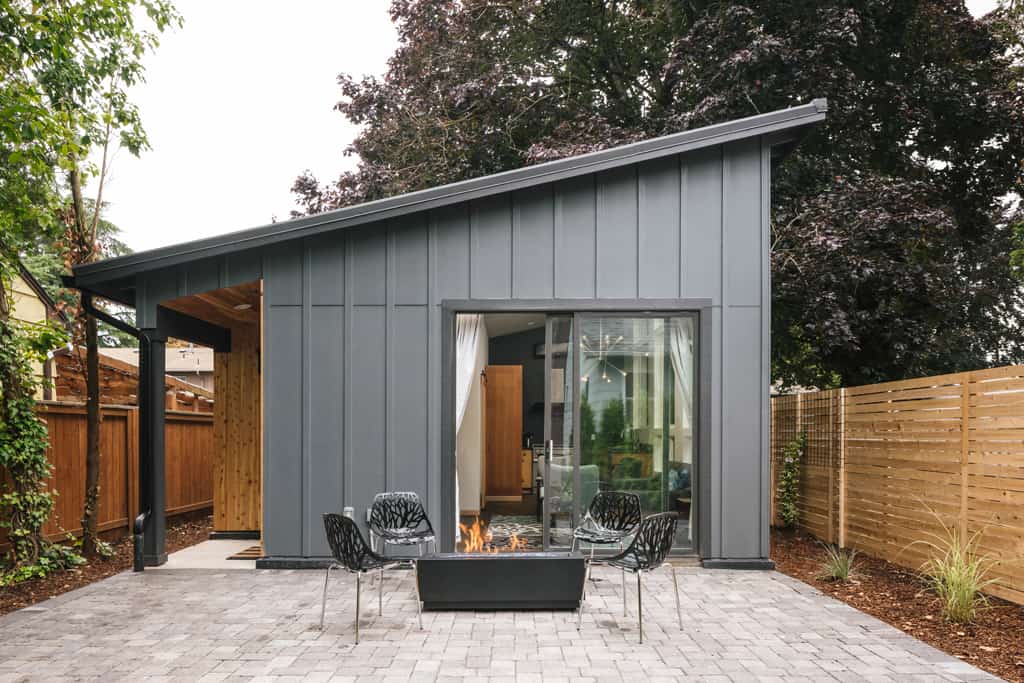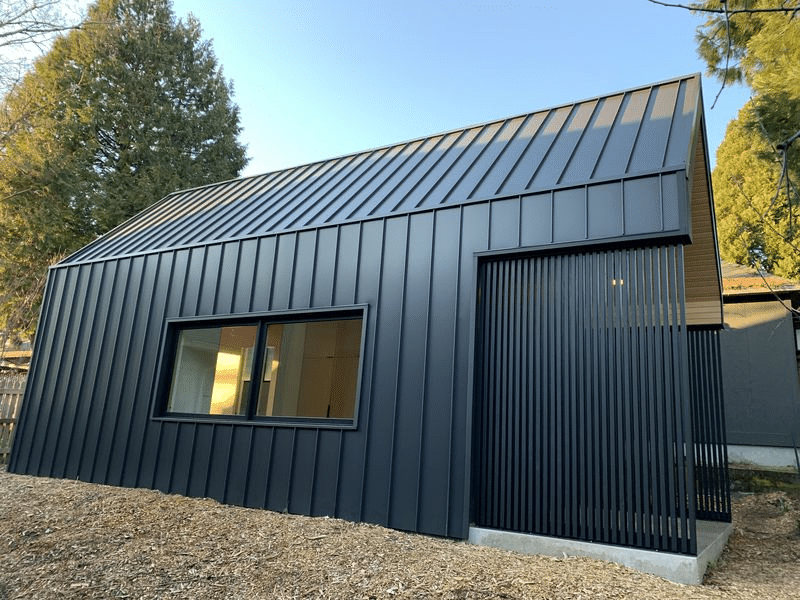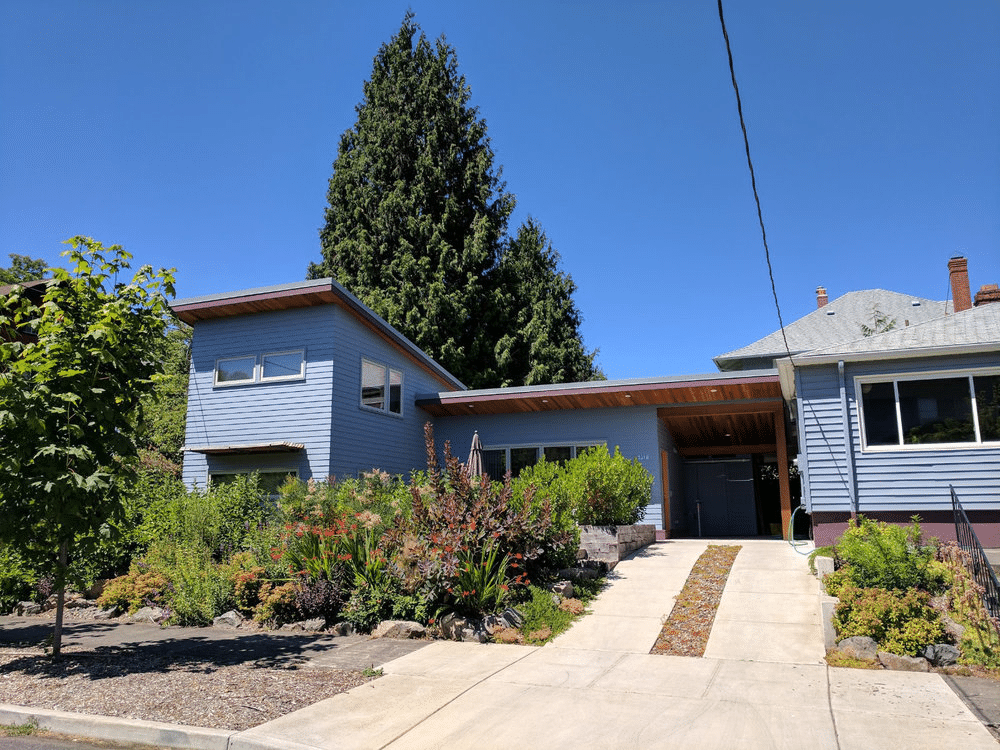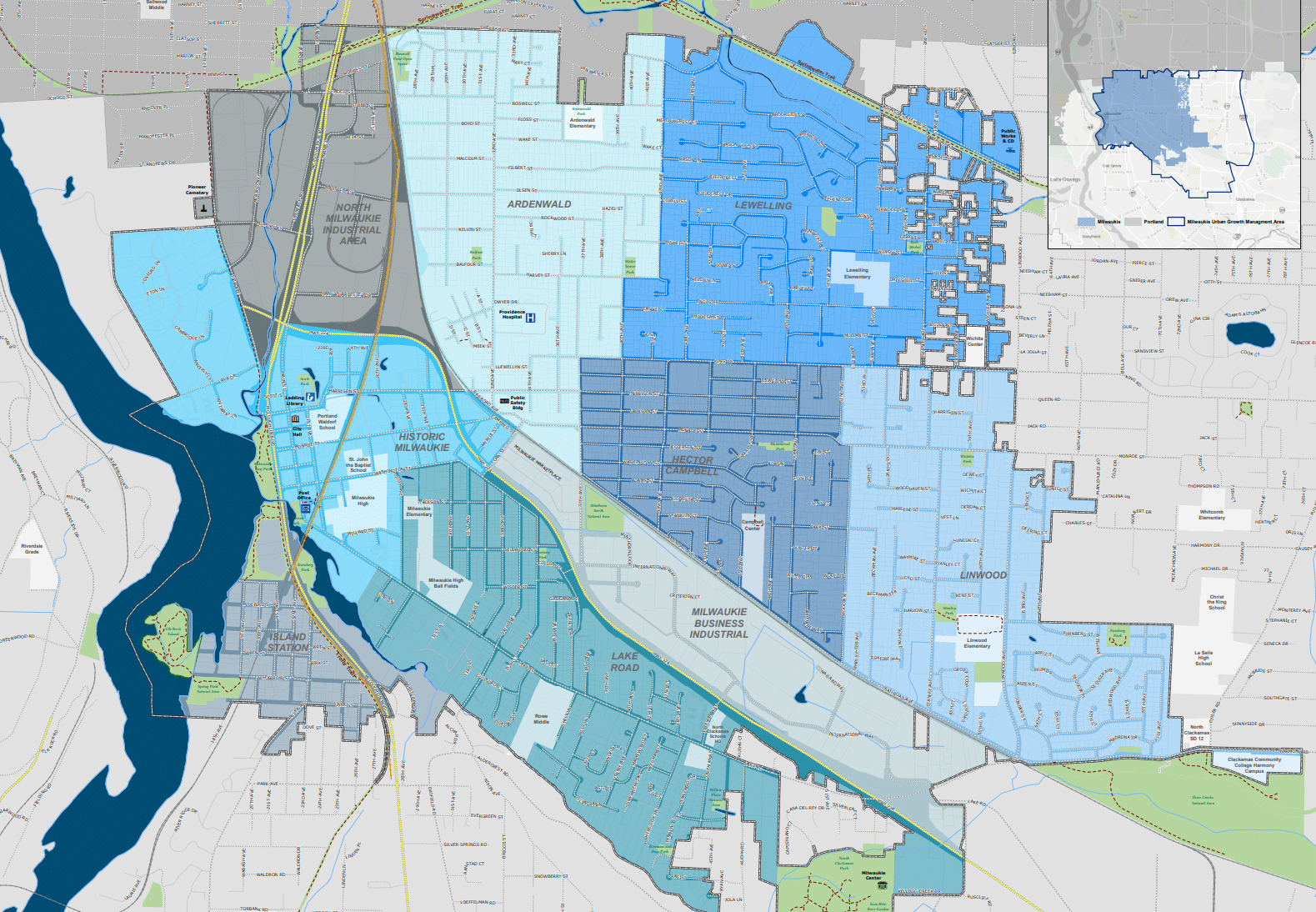Portland, Oregon ADU Guide. Everything You Need To Know

Updated 10/2024.
Are ADUs a passing craze or a trend that’s here to stay? From the look of it, at least in Portland, it’s the latter. Thanks to the city’s new ADU rules and regulations, Portland homeowners can now capitalize on this new trend, not only creating consistent monthly rental income but also adding to the value of their homes for resale.
ADUs can vary in size and price, and the rules and regulations around their construction are different from those for standard-sized single-family dwellings. Adding an ADU to your property or buying a home with an existing ADU can transform you into a landlord if you choose to use it for long-term rental income.
See all homes for sale in Portland with existing ADUs or potential for future ADUs.
Undoubtedly, it can all be intimidating enough to deter many from taking the leap. However, in this article, we have gathered information on all things ADU—what they are, different types, potential costs, rules and regulations, and more to set you up for success when you decide to take the plunge.
What Is an ADU in Portland?
Additional Dwelling Units, or ADUs, have been around for a while, known by various names: she sheds, mother-in-law-suites, backyard apartments, and granny suites. These tiny, functional dwellings are, at most, 800 sq. ft., but no more than 75% of the main house’s square footage. At the very least, an ADU has living quarters, a bathroom, and a kitchen.
ADUs can be small units incorporated into an existing home (think basements, attics, and additions) or be added as a detached primary residence on the same property as a main house.
ADUs are used for a variety of purposes. These days, retirement-aged singles and couples are moving into ADUs in their grown kids’ backyards, ensuring financial security, aging-in-place options, and easy access to family. Work-from-home scenarios over the past couple of years have also nudged people to create functional, at-home workspaces separate from the main house’s living spaces. Others maintain an ADU for short- and long-term rentals, generating the additional income mentioned above.
Why Does the City of Portland Encourage ADUs?
Portland is on board with the ADU movement, thanks to the city’s Residential Infill Project, which rolled out its second phase in June 2022, expanding the possibilities for ADUs of all kinds across Portland proper. In fact, the city’s proactive approach to all ADUs has gained a national presence, as evidenced by its mention in an article published by the Department of Housing and Urban Development (HUD). They report information from Portland’s Cascadia Partners strategic partner, Robert Liberty, who says, “At the most basic level, jurisdictions should not impose burdens on ADUs that they do not impose on single-family homes.“
Why does Portland value ADUs? One reason is to add density to Portland’s 145-square-mile footprint, allowing more people to live closer to work and city amenities while cutting down on transportation needs. Staying closer to Portland also keeps dollars local, bolstering the local economy.
Oregon also has land-use laws to slow city growth into the countryside, known as the Urban Growth Boundary (UBG). Portland will likely expand the UGB over future decades, but ADUs offer a more immediate solution for more housing through infill.
A third reason is to keep Portland’s character. In 2015, Portland’s Bureau of Planning and Sustainability (BPS) recognized the need for infill without diminishing Portland’s unique streetscapes and neighborhoods. ADUs help accomplish this goal while also accommodating the “missing middle”—homes that are bigger than apartments and offer more independent living, yet smaller than most single-family homes.
ADUs are also a quick, affordable, and relatively simple solution to help relieve the housing crisis, making it a realistic solution for Portland as a whole. Generally speaking, ADUs run at least half the expense of standard-size home construction, but they also rent for less, increasing the pool of potential tenants for the owner and providing housing options for renters in neighborhoods they may not have been able to afford otherwise.
Unlike expanding housing into undeveloped land, building ADUs also allows for more use of existing infrastructure, saving taxpayer money. It should be noted that it can also bring added strain to existing systems that may require an upgrade, but it allows the systems to be used to their potential.
Are ADUs Here to Stay?
Not only has Portland embraced the growing ADU trend, but so has President Biden’s administration. To offset the country’s housing shortage, Biden released his Housing Supply Action Plan in May 2022. The goal of the Housing Supply Action Plan is to boost the supply of quality housing, thus reducing housing costs, within five years. The Biden administration has also followed this plan with new actions to boost housing supply and lower housing costs overall.
One facet of the plan highlights ADU construction reforms at the state and local levels while offering better financial options. If implemented and followed as planned, this move could generate over 1M ADUs across the country within five years and as many as 4.7M over the next decade.
For many of the same reasons listed above, cities and states across the country have lightened ADU restrictions over the past few years, making this housing solution a viable response to the housing crisis. With both national and local steps to normalize the construction and use of ADUs as primary living dwellings, it seems that this innovative housing solution’s time has come.
ADUs as Income Generators in Portland
According to the National Association of Realtors (NAR), having one ADU on your property can add as much as 35% of your home’s value. While this isn’t immediate income in your pocket, over the long haul, it could be.
In addition to the overall value an ADU will add to your property, meaning a higher sales price when the time comes, ADUs are also excellent monthly income generators. Now that Portland allows more than one ADU per lot or property with a single-family home, the potential for rental income and providing affordable housing to renters increases exponentially.
Imagine adding a side-by-side or stacked ADU or a cottage cluster—a group of small dwellings centered around an urban garden or courtyard. The room above your garage? In your garage? Basement? Using existing space or building out on the side or back of your home can make adding or extending plumbing easier, also saving you money.
Rentcafe.com reports that the average Portland rent for a 756 sq. ft. apartment is $1,746. Do the math, and you’ll see that you could generate just under $21K annually. Add two ADUs and double that amount—you get $42K.
Incentives to Encourage ADUs in Portland
To encourage homeowners to add ADUs to their properties, the City of Portland has waived the usual $15K development cost so long as the new property isn’t used as a short-term rental for ten years. If this promise from the owner is not honored, the development fees must be paid, plus a 50% penalty. This waiver isn’t new. It’s been in effect since 2010. However, the new Systems Development Charge Waiver makes it permanent. Thanks to this waiver, new ADUs in Portland have grown from 50 to 500 annually. Apply for a development charge waiver.
Pros and Cons of ADUs
As with most situations and scenarios in life, there are potential trade-offs. This is certainly true when considering adding an ADU to your property. The decision to put an additional residential structure on a property is a personal choice, requiring ample time, consideration, and planning.
It helps, first, to seriously consider your reasons for wanting to build an ADU. Here are a few nudging people to move forward.
Reasons to Build an ADU
■ Create more living space for extended family for short stays or a more permanent living situation
■ Continue to work from home without the disruptions of having a workspace in the middle of all the family hubbub
■ Make an art studio or hobby room to give you space to feel the flow and craft your creations
■ Maintain property rights while downsizing and staying in the neighborhood you love
■ Create an income stream—while living in the ADU, leaving the main house to be rented, or vice versa
And now… on to the pros and cons of having an ADU on your property.
■ Generate passive income for yourself: The extra money per month can help you recoup your investment and add to your monthly bank account.
■ Provide affordable housing to others: With the current housing crisis, you can provide a home for those who would not otherwise be able to live in your neighborhood or find housing at all.
■ Increase your property value: The added square footage and functionality bring a higher selling price in the market.
■ Provide a home for aging members: The elderly can gain comfortable accommodations while saving money while allowing others to take care of them more easily. We dive more into “age-in-place” living further into this article.
■ Less Environmental Impact: Having more high-density living reduces the carbon footprint. Small homes consume less energy for heating and cooling, making ADUs inherently more sustainable.
■ Cost: ADUs require an initial investment for construction and permitting.
■ Increased property taxes: Learn more about ADUs and Portland property taxes.
■ Ongoing maintenance: You’ll need to do more gutter and air duct cleaning, appliance maintenance, and other general upkeep required of any living space
■ Utility issues: The utility systems may require an upgrade to allow for the added strain in usage. Additionally, utility costs will likely rise and be required of you unless you pass the bill on to renters.
■ Potential lack of privacy: You may be within earshot or eyesight of renters when they hold gatherings.
■ Neighbor complaints: You may create a louder property, disrupt views for others, and take up street parking.
If you’re interested in approaching your ADU construction from an investor’s standpoint, read Part I and Part II of “ADUs from an Investor’s Perspective.”
ADU Permits, Rules, and Regulations in Portland
Things to Consider Before Building an ADU
Before beginning construction on an ADU, it’s important to check the rules and regulations in the Portland area. You should be up-to-date on all building permits and be aware of the zoning restrictions placed on certain buildings. It is worth noting that while some duplexes and triplexes can qualify for an ADU (restrictions apply), higher buildings do not qualify.
Another thing to consider is how a detached ADU will impact your neighbors. Consider conducting a sunlight study to see how the building would impact your neighbor’s sunlight or even your own property. This allows you to determine if your building would significantly impact the land value and quality of light for you and your neighbors.
You should also consider how to connect your detached ADU to water, sanitary, and storm sewer facilities. Since the rules for ADU are constantly evolving, check this resource to stay current.
How Big Can an ADU Be?
An ADU cannot be more than 75% of the living area of your primary dwelling (the main structure). The primary structure means things like your home or the larger of two units in a duplex. Regardless of the size of the primary dwelling, an ADU cannot exceed 800 square feet. The total living area should be either 75% of the living area or 800 square feet, whichever is less. So, if you have a home that is 2,000 square feet, your limit would still be 800 square feet, even though 75% of the dwelling would be 1,500 square feet.
There are some exceptions to the size of an ADU, namely, if the ADU is in the basement of a property over five years old. The following things are excluded when calculating ADU size:
■ Exterior wall thickness
■ Garages
■ Basements where the ceiling is lower than six feet eight inches
■ Any building area with a height of under 5 feet to the ceiling or areas not accessible by a stairway
Check out the Portland zoning requirements for more information about ADU building size limits and square footage.
What Permits Do You Need for an ADU?
Here’s a look at what permits are needed.
● You will need a building permit to convert an existing space to an ADU or build a freestanding ADU.
● You will likely need an electrical, plumbing, and mechanical permit to outfit the space fully.
● Building a freestanding ADU follows the New Single Family Residence guidelines.
● Converting a space into an ADU also requires a building permit and may constitute a Major Residential Alteration and Addition, which has its own permit requirements that can be found here.
You must properly file and submit all building permit applications before beginning construction.
Cost of Adding an ADU to Your Property
The first thing to remember when approaching the cost of adding an ADU to your property is permit costs. Since permit costs fluctuate depending on the year, we recommend checking out the current Portland fees and schedules page. Remember that for the building permit alone, you could be looking at anything from $145 to upwards of $1,000, depending on the total work cost.
Speaking of the total cost, an ADU costs between $60,000 and $360,000, depending on whether it is a renovation of an existing space or a standalone building. A general average cost falls around $180,000. Keep in mind that with the rise in construction costs, especially the cost of materials, homeowners looking to install an ADU may see a dramatic cost increase in building a detached ADU.
For building a freestanding ADU in 2024, Angi estimates the following costs:
| ADU Size (sq. ft.) | Average Min Price | Average Max Price |
| 400 sq. ft. | $60,000 | $120,000 |
| 600 sq. ft. | $90,000 | $180,000 |
| 750 sq. ft. | $112,500 | $225,000 |
| 1,000 sq. ft. | $150,000 | $300,000 |
| 1,200 sq. ft. | $180,000 | $360,000 |
ADU Financing Options and Incentives
There are many financing options for buying or updating a home. Homeowners can explore options like the Fannie Mae HomeStyle Renovation loan or Freddie Mac’s CHOICERenovation mortgage. Additionally, Portland offers incentives such as property tax exemptions and low-interest loans. Other options include home equity loans and home equity lines of credit, also known as “second mortgages”.
Learn How to Build an ADU on Your Property
Portland is full of ADU proponents, many of whom have the knowledge and skills to show you how to design and build your own.
Building and ADU on Your Property in Portland, Oregon
Accessible Dwelling Unit Primer Course
ADU and Tiny House Design Classes at PCC
Accessory Dwelling Unit Primer Course
ADU Specialist Accreditation Programs
Types of ADUs
Low-cost ADUs
While ADUs cost less than standard-sized homes to build and maintain, price is a still a consideration. The development fee waiver goes a long way in making the path to ADU ownership more viable. There are also other choices that make adding an ADU to your property more affordable.
■ Refurbish a shed or other existing outbuilding
■ Remodel a garage (a two-car garage could become two ADUs, etc.)
■ Renovate an attic space (See Attic ADUs below)
■ Finish a basement (See Basement ADUs below)
■ Build small and focus on essentials—even building from the ground up can be low-cost with the right planning, design, materials, and assistance (See ADU Designers in Portland and ADU Builders in Portland below)
Up-Scale ADUs
Not all ADUs are—or need to be—low-cost. If you have the budget for it, creating a posh but small living space—for yourself while you rent out your main house—can be a great way to reduce your carbon footprint or downscale with style as an empty nester without compromising on the quality of your living space.

Take, for instance, this 252-sq. ft. ADU in Portland’s Richmond neighborhood, which was built with classic board-and-batten siding and a steel roof. One factor increasing the cost of this home was the added trees and plants to serve as privacy screens. The home also boasts skylights and a glass door for ample natural light.
Owner: May Leong / Designer: Willie Dean of Ground Up Design Works / Builder: Environs
Other ADU Designs
Sustainable ADUs
It could be argued that ADUs are inherently sustainable simply by virtue of their size—smaller dwellings require less energy to heat and cool.
They also directly address the problem of urban sprawl, reducing humans’ carbon footprint on the earth. Beyond these built-in perks ADUs possess, many ADU designers and builders have embraced the practice of using sustainable materials. ADUs also create density, which usually means decreased vehicle use, resulting in lower fuel emissions. Because ADUs use less to build, they generally cost less to build, thus allowing for the most up-to-date technologies. Building costs are also lessened because labor costs are lower. When it comes to saving with an ADU, the small savings start to add up, leading to a domino effect where you save more money than you thought possible.
Take, for instance, this split ADU built in SE Portland by Propel Studio. Constructed with sustainably harvested wood products, locally sourced materials, sun shades on the windows, low-flow appliances, radiant floor heating, LED lighting, and spray foam insulation in the ceiling, along with landscaping that includes native plants, thus eliminating the need for irrigation, this home is a testament to eco-friendly construction. The roofs were also designed and installed to open the possibility of solar panels in the future.

Architect: Propel Studio
Accessible ADUs
One of Portland’s ADUs rules is that if you have more than two structures on your property—a larger main house and an ADU—one of the structures needs to be ADA accessible, meaning that it needs to be easily accessible for someone in a wheelchair or with other mobility constraints.
Some exemptions for this requirement include:
■ You use an existing accessory structure that’s at least 5 years old
■ You convert an existing part of your home—basement or attic, for example—and your home is at least 5 years old
■ Your lot has an average slope of 20 percent or more
■ Your lot has a rise of more than three feet from the highest point along the street and the lowest point at the front setback
A ramp would be one example of an ADA-accessible entrance, for example. Some features of an ADA-accessible home are:
■ Build a single-level walk-out ADU
■ Entrance level with the ground/sidewalk
■ Wide doorways—at least 32″ wide – 36″ is optimum
■ Offset hinges (aka “Z” hinges)—allow doors to swing clear of the doorway and can add as much as one inch of passage room
■ Eliminate door trim
■ Incorporate pocket, barn, or Shoji sliding doors (made of rice paper)
■ Curtains or other textiles for the doorway
Age-in-Place ADUs
The term “age-in-place” usually conjures images of hospital-like environments with grab bars, shower seats, and walk-in showers. But age-in-place means far more than this outdated, stereotypical view of retirees.
It’s becoming increasingly common these days for people at retirement age to move into age-in-place ADUs in their grown kids’ backyards. Not only are they downsizing and putting themselves in close proximity to grandkids, they’re also ensuring they have a space that will serve them as they age.
This could mean that rather than needing to move into an assisted living facility, they can remain somewhat independent while having family close by in case of an emergency. On top of this, the overall cost of hiring a caretaker to visit your home versus paying for an assisted living facility can be much lower, meaning you save money in the long run while keeping your loved ones close by.
Not only can an ADU allow seniors to live close to their family, which has a wide range of health benefits and keeps them feeling connected, but it can also help with the ongoing senior living crisis.
Value-Added ADUs
The value-added ADU equates to a structure with growth potential. Imagine a small single-level, ranch-style ADU with a basement, creating the potential for further development of a lower-level ADU. By looking at your ADU as a potential multistage project, you can add more value to your home.
For example, suppose you’re looking to build a small ADU, but want to potentially expand the building in the future. Perhaps you’re expecting your adult children to move in with their family down the road. You can build an ADU with additional space for the future by adding a basement or other undeveloped space to the building. By combining an ADU with a potential value-added space, you plan for the future and give yourself more potential income should you want to rent out the ADU in the future.
Bump-Out / Side-Addition ADUs
Bump-out and side-addition ADUs require more yard space (if on ground level) and are costlier than building up, but if you have the space and the budget, this is a viable option. Bump-outs can also be cantilevered structures that protrude beyond the original boundaries of a single-family dwelling, meaning they don’t require a foundation. Not only does it allow you to use the HVAC from the main home, but you can save money by running the electric and plumbing from the main building.
Plus, by not building a new structure, you save yourself money in the long run while adding to the value of your main home. Keep in mind this structure of ADU may not work for duplexes or other buildings with a secondary dwelling attached.
Side-by-Side / Stacked ADUs
When you think of a side-by-side ADU, think of a mini duplex. These style of ADU typically share a wall, and function similarly to a traditional duplex. It is worth noting that due to the regulations in Portland, Oregon you may run into issues building an ADU attached to an already existing duplex.
A stacked ADU, or vertical duplex, is one way to conserve your yard space and also save on costs. Because you don’t have to worry about pouring an additional foundation, you can save on some material costs while also conserving the existing space on your property. Keep in mind that it can be more complicated to build an ADU this way, as you’ll need to get the required building permits and should conduct a shadow and sunlight study to see how your new ADU impacts you and your neighbor’s natural lightning and sunlight exposure.
Garage / Above-Garage ADUs
One benefit of above garage or garage ADUs is you can work from existing amenities. For example, your garage has its own shell, and usually has a foundation. This saves you on construction and material costs. On top of this, because your garage attaches to your regular house, you can tap into some of the amenities in your home, such as the kitchen plumbing and HVAC system. By connecting to existing plumbing and ductwork, you can save yourself money, leading to even more savings from your ADU.
Basement ADUs
As with garage ADUs, when converting a basement space into additional living quarters, you’re limited by what already exists, and maybe even more—building up or out is not a possibility. However, creating a basement ADU can be one of the most cost-effective and easiest ways to go, with the benefits outweighing the limitations.
■ You save on excavation and construction costs—the space already exists.
■ Energy costs will likely be lower—with the space embedded in the earth, temperatures run moderate.
■ You salvage yard space—no need to alter precious space you’re used to enjoying.
■ The ability to change your mind later exists
■ You create inconspicuous density—more available housing without changing the character of the neighborhood.
■ Utilities already in place—if they aren’t directly accessible from the basement, connecting from the home is easy.
We’d be remiss if we didn’t mention potential problems when converting basements to ADUs. They may include:
■ Ceiling height—the City of Portland requires a 6’8″ ceiling height on all finished dwellings. This is the distance from the top of the finished flooring to the ceiling, so you also have to account for the thickness of the sub-flooring, any insulation, and the flooring itself. Also, if you decide to add soundproofing to the ceiling (highly recommended), there goes even more space.
■ Portland does allow beams and other objects to be 6 foot 2 inches high, so long as they’re only a small percentage of the space itself. While you can dig down in your basement, be prepared to add between $10K and $20K to the project to account for the added labor.
■ Exterior entrance—not all homes are built with the ability to create an easily accessible designated entrance without entering the main house.
■ Shared space—While you won’t have non-family living in your home, you will have them in your space. This means you’ll be able to hear other people through the floor and potentially share outdoor spaces with them unless you build a partition. Even with a partition, you are sacrificing some of your privacy for a basement ADU.
For more resources for a basement ADU, check out the following:
■ Basement ADUs: 2020 Portland Guide
■ Basement ADUs in Portland, 10 Things to Know
■ Derin & Andra William’s ADU: An Energy-Efficient Basement Apartment
Attic ADUs
Before you jump on building an attic ADU, there are a lot of things to consider. First, you’ll likely need to get a building permit for your project and stay up to code on all entrances to your attic space. Secondly, you’ll need insulation and other basic fixtures in your attic.
Another thing to keep in mind is like the basement ADU, it’s difficult to have an individual entrance to your attic, meaning you may have non-family members walking through your house to access the ADU.
And don’t forget the HVAC! Attics have the opposite problem of a basement where they tend to run warm in the summer and cold in the winter months, meaning you’ll want to invest in insulation.
That being said, an attic ADU can be a great way to take advantage of existing space, and act as a mother-in-law suite or second living space in your home. You can easily tap into existing fixtures like plumbing and electrical, and in many cases your attic is already designated as its own separate space from your home.
For more tips and tricks for remodeling your attic, check out our article on the subject.
Cottage Cluster ADUs
Eugene Code Section (EC) 9.0500 defines a cottage cluster as “A grouping of no fewer than four detached dwellings per acre with a footprint of less than 900 square feet each that includes a common courtyard. Cottage clusters are not fourplexes or multiple-unit dwellings.” This means that a grouping of four to eight freestanding ADUs counts as a cottage cluster. This can be a great way to have more than one ADU on your property, though there are specific requirements to keep in mind when building a cottage cluster.
With the implementation of RIP2 (Residential Infill Project), the number of applicable zones for duplexes and cottage clusters has grown. The goal of this is to allow for more housing in the Portland area and to turn existing single-family homes into housing fit for several families. If you’re looking for a way to turn your existing property into a rental property, a cottage cluster could be a worthwhile investment. And thanks to RIP2, there are more pieces of property that count for these buildings.
You can learn more about cottage housing and how these ADUs are reshaping the real estate market and offsetting the housing crisis in Clackamas County here.
ADU Kits
Difference Between Prefab and Custom ADU Kits
A prefab ADU kit is made to fit certain dimensions. In most cases, the customer has little control over the end result, and gets to choose from a set of predetermined factors, like general size, color, and layout. In a custom ADU kit, the client decides many of the interior and exterior features of the ADU, and has more creative control over the end result. It’s no surprise that ADU custom kits tend to be more expensive than their prefab counterparts.
One of the main differences between prefab and custom ADU kits is the blueprint or design fee. In a custom kit, you pay the blueprint fee upfront, which can make up between $8,000 and $25,000 of your total cost. However, for a prefab ADU, this cost is built into the overall cost of the prefab.
There are other factors to consider as well, including:
■ Prefabs are inspected by the factory
■ Prefabs have preapproved plans
■ Prefabs may cost less labor-wise
■ Prefabs can cut down on extra costs, like a Port-a-Potty for workers
Some companies in and around Portland, Oregon that create prefab and custom ADU kits include:
■ Ideabox
■ Dweller
■ ADU PDX
Shipping Container ADUs
Shipping containers come between 160 and 320 square feet, making them ideal for an ADU. It is worth noting that a shipping container ADU comes with additional costs, like moving the shipping container to your property and, of course, sourcing the container. However, these box-like ADUs can cut down on your design choices as they’re all one basic shape, which can streamline the ADU process. One of the primary companies that make these units in Portland, Oregon, is Relevant Buildings. If you’re looking for some shipping container ADU inspiration, their website is a veritable goldmine of creative ADUs.
Additional ADU Resources in Portland
Tiny Homes on Wheels ADUs
While tiny homes on wheels may seem attractive, there are a few disadvantages to keep in mind. For example, you cannot connect a wheeled tiny home to a permanent septic system, meaning you’ll need another way to get water and handle waste. On top of this, you may run into financing issues for wheeled tiny homes, since they do not have the same amenities as a traditional home.
On the upside, a wheeled tiny home can go nearly anywhere if built correctly, allowing you the freedom to take your home with you when you travel. You can also build a tiny home ADU for a fraction of the cost of a full-sized family home, making it a cheaper alternative to traditional housing.
Here are some companies that offer tiny home plans and construction:
ADU Designers in Portland
Here are some of the ADU designers in Portland. These designers either focus on ADUs or offer ADUs and full-sized home plans.
ADU Builders in Portland
These builders build ADUs and traditional buildings in some cases, making them all-around experts when it comes to building dwellings.
Work With an Experienced, Licensed Portland Real Estate Agent
Whether you’re looking to buy a home with an existing ADU, buy a large lot to build your own ADU, or sell a home, our experienced, top 1% Portland real estate agents are here to help. We know ADUs and look forward to working with you on your next project. Give us a call today at 503-714-1111 or chat with the bot on our site.


